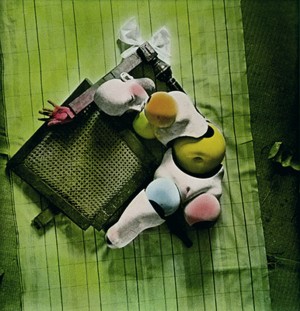|
|
Ball-jointed dolls
- Objects made to resemble the human form can be seen in civilizations and ethnic groups all over the world.
- Originally, these objects appear to have carried strong magical or religious meanings, as they were used for such purposes as praying for good harvests, fertility, and the repose of the dead. As civilization developed, human-shaped objects came to be divided into categories such as idols, sculptures, and dolls, and a varied range of these objects were produced prior to the advent of the modern figurine.
- Ball-jointed dolls are one such type of human-shaped object. These dolls originated in the early 20th century, when Hans Bellmer discovered articulated dolls made by the Durer School in the 16th century, and elevated this type of doll to an art.
- Born in Poland in 1902, Bellmer created dolls as “anagrams”, various combinations of limbs and bodies which he linked together with ball-joints. These dolls were then used to produce fetish photography. This artwork gained widespread attention after being promoted by André Breton, author of the Surrealist Manifesto.
 Bellmer's ball-jointed doll photo
Bellmer's ball-jointed doll photo
- Bellmer’s ball-jointed dolls were introduced to Japan in the 1960s by Tatsuhiko Shibusawa. This led to the appearance of a number of artists who used ball-jointed dolls as forms of artistic expression. Many of these artists opened doll-making schools, allowing this artistic style to be handed down to a new generation of artists, who continue to use dolls to search for their own varied means of expression. It can be argued that ball-jointed dolls are now becoming a uniquely Japanese art form.
- I first learned about such dolls in 2006, when I took part in a doll-making class. Bellmer took ball-joints as an expression of fetishism, but I take the kinetic nature of movement through ball-joints to express a symbol of life (a signe).
- My inspiration for this is drawn from Tai Chi. Tai Chi involves visualizing the joints as spheres and engaging in repeated circular movement to reach a state where heaven and earth are connected. I feel this approach suits me better than the one linked to fetishism.
- For the future, I aim to keep my eyes fixed on the "human being" while continuing to create "human forms."
- 2012.6
Glass eyes
- Glass, the first man-made material, was invented around 5,000 years ago by the civilization that inhabited Mesopotamia. Since then, glass items were fabricated by a technique called Pâte de verre, whereby powdered glass is placed in a mold and fired. This technique, however, required a great deal of effort. It was eventually made obsolete by the faster method of glass blowing.
- This ancient glass making technique was revived at the end of the 19th century by Art Nouveau glass artists. But it was kept a secret and was taken to the grave by the artists.
- The last several decades have seen further evolution in glass technology, and it is now developing at a rapid pace. Glass is presently used not only for dishes and tableware but has become essential in a wide variety of industries that range from electronics to communications.
- In Europe, artificial eyes were originally made by glass blowing. In Japan, from the late Heian period onward, much Buddhist statuary incorporated eyes made from crystal. The glass eyes made the statues seem to come to life. Nowadays, doll eyes are made with glass or with materials such as plastic and silicon.
- The expression projected by the eyes brings life to a doll.
- At lamp making classes I used resin for the first time and there I learned about making eyes with it. However, I realized these eyes did not properly match my works, and so I decided to use wood to create eyes until I was able to craft the kind of eyes I wanted. Then, as I explored, I encountered the ancient glass technique of Pâte de verre. There is no established method of creating artificial eyes with this technique, so I started from scratch. After much trial and error, I recently succeeded in making glass eyes that match my style. I want to continue investigating details and adjusting colors. Using these techniques, I would like to develop items such as doll stands and doll parts.
- 2012.6
Self-produced glass eyes made by Pâte de verre